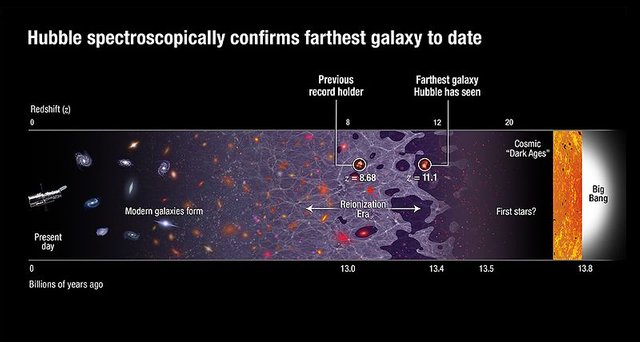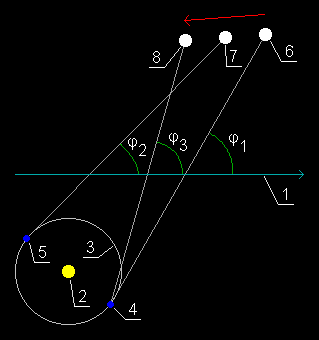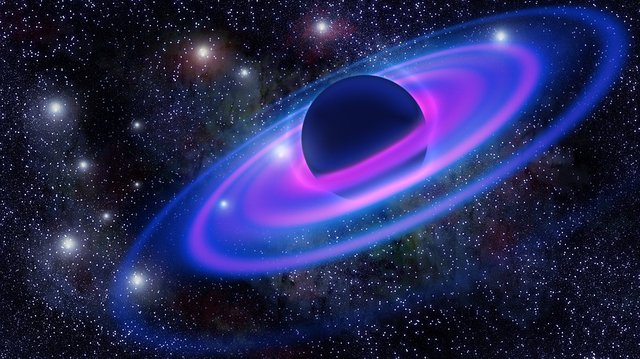Have you ever wondered how big our universe is? Large enough, very broad, or the infinite extent? This question is a big question faced by astronomers in the early 20th century. Although it sounds as a simple question, it takes deep research to be able to find the real answer.
The Great Debate
"Let's talk about the size of the universe," says American astronomer Harlow Shapley in opening his presentation. At that time, Shapley was speaking at a conference known as the "Great Debate" in Washington DC in 1920. It also attended Heber Curtis, which was the opposite of Shapley's debate. Shapley believes that the Milky Way galaxy measuring 300,000 light years. This size is actually three times larger than the size we know today. However, in Shapley's time, these measurements were quite precise.
At the beginning of the 20th century, it is well known that the Milky Way galaxy is a spiral galaxy. The strange thing is how a spiral galaxy might be that big. Moreover, Shapley argued that our universe is fully filled only by the Milky Way galaxy. It was this argument that triggered Curtis's disapproval. Curtis argues that the Milky Way is not the only galaxy in the universe. There are many galaxies that are even larger than the Milky Way scattered in the universe. Furthermore, Curtis delivered his calculations that the size of the Milky Way is actually only 30,000 light-years away. Unfortunately, this result turned out to be incorrect, much smaller than the calculations in modern times that we know, which is threefold.
When we talk about measuring errors that are three times bigger or smaller, it is only natural that astronomers now have a false picture of the true size of the Milky Way. Currently, we know that the true diameter of the Milky Way is about 100,000 to 150,000 light-years away. While the size of the observed universe is much larger, with a diameter of about 93 billion light years. But how can we be sure? How can astronomers measure that distance just from Earth?
Ladder of Cosmic Distance
In order to measure distance in the universe, astronomers have developed a variety of methods known as "ladders of cosmic distance". The first rung of the ladder is quite easy to use in the presence of modern technology today. We can use the reflection of radio waves that we send to nearby planets like Venus and Mars. Yes, this is the same principle as when we use radar. By measuring the time it takes the signal from start to be transmitted until its reflection is received, we can know the distance to the planets accurately. Large radio telescopes such as Arecibo in Puerto Rico can perform such measurements. Even the telescope can also detect and measure the distances of asteroids that roam the Solar System.

However, using radio waves to measure distances outside the Solar System is not practical. The next step that can be used is parallax. This method has actually been applied in our daily lives. Man realizes the distance between himself and the object around him because it has two eyes. If you put an object - for example, your index finger - in front of your face and see it with your right eye only, then you see it again with your left eye, you will feel that your finger seems to shift. This is called parallax. The apparent shift can be used to measure the distance of an object. Our brain can do it automatically from the information that our eyes give us. Astronomers do the same thing to measure the distance of stars by using a telescope.

commons.wikimedia
The parallax method used by astronomers utilizes the movement of the Earth around the Sun. For example, if they measure the star position in the sky in January, then six months later (in July) they measure the star's position again, they can determine the magnitude of the parallax angle formed by the apparent shift of the star being reviewed. This parallax angle can be used to calculate the distance to the star. Unfortunately, the parallax method is only accurate to measure stars with a certain distance only. For example, parallax measurements by Hipparcos satellites are only accurate for stars with a distance of fewer than 200 parsecs. This is because of the farther the star distance, the smaller the parallax angle formed from the shift.
The next technique that can be used is "main sequence fitting". This technique relies on the knowledge of the relationship between the size and brightness of the main sequence stars. By measuring the color and magnitude of a star, then comparing it with the main sequence stars whose distance has been measured using parallax, we can estimate the distance of the star. The principle used in this technique is that the stars with the same mass and age should have the same brightness. It means the dimmer star of the main sequence star, perhaps the further its position from us and vice versa.
Candle of Distance Detector
The main sequence stars used in the main sequence fitting are included in one type of wax determinant. That is, the distance of stars can be calculated accurately by measuring the magnitude of the star. Unfortunately, this method is also difficult to use if you want to measure the distance between the interactions. The main sequence stars lying outside the Milky Way are usually very dim and difficult to observe accurately. In 1908, a female astronomer named Henrietta Swan Leavitt discovered another type of star that could be used as a wax determining distance. This star is called the Cepheid variable star. This star is called a variable because it is pulsed so that its brightness varies - sometimes bright, sometimes dim. The bright cepheids tend to slow down more slowly, while the fainter ones are pulsed faster. Since the Cepheid pulse rate can be measured easily, astronomers can calculate the brightness of the Cepheid. From the brightness can be determined the actual distance of the star from us. In 1920, Edwin Hubble detected Cepheid in the Andromeda galaxy and found that the galaxy's distances are around millions of light-years away. It is now known that our distance to Andromeda is 2.54 million light years.
Hubble measurements do not stop there. Hubble also measured the brightness of a white dwarf that exploded into a Type Ia supernova. Supernova is a very bright starburst. Supernove type It is a supernova formed from a white dwarf double star system and a normal star that exceeds the Chandrasekhar limit. So bright can even be observed in galaxies that are billions of light years away. The brightness can be used to measure the distance to the supernova.
Another method used to measure the distances of further galaxies is by measuring redshift. Redshift deals with the inexplicable effects of Doppler such as when you hear police sirens or ambulances passing near you. As the ambulance approaches you, the frequency of siren sounds higher and then, when the ambulance away from you, the sound is lower. The same thing happens to light waves. We can examine the changes by analyzing the spectra of distant objects (eg stars or galaxies). This spectrum usually has dark lines because the light at a certain wavelength is absorbed by the chemical elements inside or outside the object.
The farther away the object is from us, the dark lines shift toward the more red spectrum. Hubble analyzed the spectra of galaxies outside the Milky Way and found that the majority of such galaxies were redshifted. The farther away a galaxy, the bigger the redshift. This happens not only because the location of the object is far from us, but also because the object is away from us as time goes by. Hubble's invention proves that the universe we live in is not silent but expands. With the expansion of the universe, every galaxy moves away from each other.
Currently, astronomers have found that the spectrum of objects that redshift is the largest comes from light that has been 13.8 billion years old. Since this light is oldest and comes from a very distant place, that light can be used to measure the age of the universe. However, during that 13.8 billion years the universe also continues to expand rapidly. With more precise calculations, astronomers estimate that the 13.8 billion-year-old light comes from what is now 46.5 billion light years away from us. Thus the diameter of the universe is observed about twice the distance from us to the most distant object, which is 93 billion light years.
Astronomers believe that the size of the observed universe is about 93 billion light-years away because it can observe light coming from the edges of the observable universe. What about the unobserved part of the universe? This question is difficult to answer because we can not observe it because there is no light coming from that place. We need another method to measure that unobserved part. You need to know that 93 billion light-years are a rough estimate. More accurate figures can only be determined when other mysteries about our universe have been answered. For example is our universe limited or unlimited and what is the true form of our universe? But at least now we know that we are very small in comparison to the vastness of the universe.
Best Regard @t4r1
Reference :
https://www.storybehindthescience.org/pdf/universe.pdf
http://www.bbc.co.uk/schools/gcsebitesize/science/triple_ocr_21c/further_physics/mapping_the_universe/revision/4/
http://www.bbc.com/earth/story/20160610-it-took-centuries-but-we-now-know-the-size-of-the-universe
https://apod.nasa.gov/htmltest/gifcity/cs_real.html
http://astronomy.nmsu.edu/geas/lectures/lecture27/slide01.html
https://terrytao.files.wordpress.com/2010/10/cosmic-distance-ladder.pdf
http://www.atnf.csiro.au/outreach/education/senior/astrophysics/variable_cepheids.html

Those are very sophisticated methods, I thought they were just using this to measure the distance:
Just kidding mate! Really good post and with top notch explanation!
Cheers!
Downvoting a post can decrease pending rewards and make it less visible. Common reasons:
Submit
Haha, that was funny. Imagine how long it would take them to measure the distance.
Downvoting a post can decrease pending rewards and make it less visible. Common reasons:
Submit
haha....
thanks @dedicateguy
Downvoting a post can decrease pending rewards and make it less visible. Common reasons:
Submit
Congratulations! This post has been upvoted from the communal account, @minnowsupport, by abumuhammad from the Minnow Support Project. It's a witness project run by aggroed, ausbitbank, teamsteem, theprophet0, someguy123, neoxian, followbtcnews, and netuoso. The goal is to help Steemit grow by supporting Minnows. Please find us at the Peace, Abundance, and Liberty Network (PALnet) Discord Channel. It's a completely public and open space to all members of the Steemit community who voluntarily choose to be there.
If you would like to delegate to the Minnow Support Project you can do so by clicking on the following links: 50SP, 100SP, 250SP, 500SP, 1000SP, 5000SP.
Be sure to leave at least 50SP undelegated on your account.
Downvoting a post can decrease pending rewards and make it less visible. Common reasons:
Submit